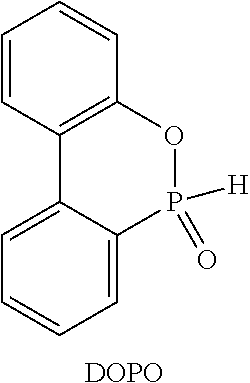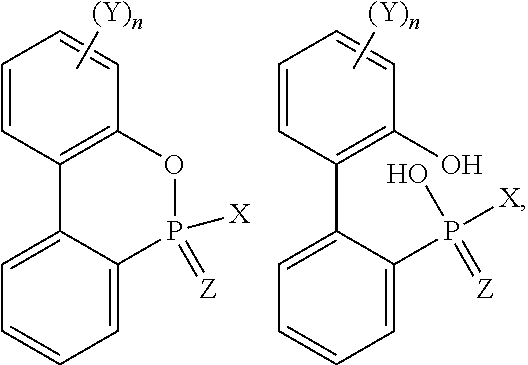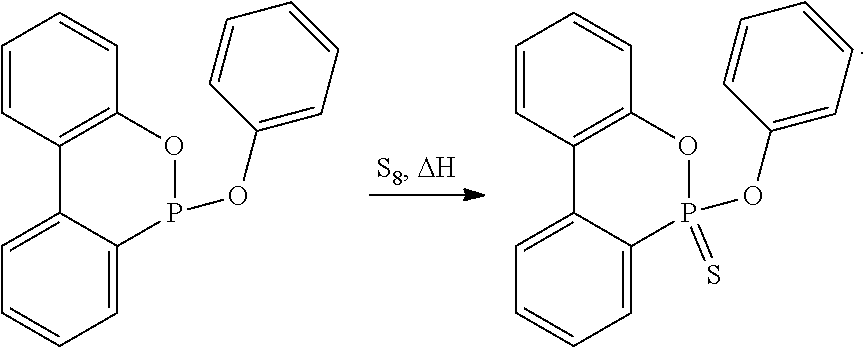Flameproof expandable polymerizates
a polymerizate and expandable technology, applied in the field of flameproof expandable polymerizates, can solve the problems that the flame retardant that may be used in compact thermoplastic polymers cannot be used in a similar way in polymeric foams, reduces the stability of suspension, interferes with or affects manufacturing methods, etc., and achieves the effect of strong effect on the foam structure and the stability of the matrix
- Summary
- Abstract
- Description
- Claims
- Application Information
AI Technical Summary
Benefits of technology
Problems solved by technology
Method used
Image
Examples
synthetic example 1
Preparation of 10-chloro-9,10-dihydro-9-oxa-10-phosphaphenanthrene (DOP-Cl)
[0124]
[0125]This starting product for the synthesis of inventive novel compounds was essentially produced according to literature (DE 20 34 887) from ortho-phenylphenol with PClS and by means of cyclization of the dichlorophosphite obtained as intermediate product using zinc chloride catalysis.
[0126]Yield: 94% of theory
synthetic example 2
Preparation of 10-chloro-9,10-dihydro-9-oxa-10-phosphaphenanthrene-10-thione or -10-sulfide (DOPS-Cl)
[0127]
[0128]This starting product for the synthesis of inventive novel compounds was essentially produced according to literature (Chernyshev et al., Zhurnal Obshchei Khimii 42(1), 93-6 (1972)) from DOP-Cl with elemental sulfur.
[0129]Yield: 88% of theory
synthetic example 3
Preparation of 9,10-dihydro-9-oxa-10-phospha-10-propylaminophenanthrene (DOP-NHPr)
[0130]
[0131]This starting product for the synthesis of inventive novel compounds was essentially produced according to literature (Ciesielski et al., Polymers for Advanced Technologies 19, 507 (2008)) from DOP-Cl and n-Propylamin.
[0132]Yield: 91% of theory
Example 1
Preparation of 9,10-dihydro-9-oxa-10-phosphaphenanthrene-10-thione or -10-sulfide (DOPS)
[0133]
[0134]While flushing with an inert gas, 28.1 g (0.12 mol) of DOP-Cl were introduced into a round-bottomed flask equipped with a gas inlet tube, a thermometer, a dropping funnel, a mechanical agitator, and a gas outlet tube, whereafter 200 mL of toluene, free of air and moisture, were added. Once DOP-Cl had been completely dissolved, H2S gas was introduced while stirring and maintaining the temperature at 25 to 30° C. After 2 h, 18.4 ml (13.4 g, 0.132 mol) of triethylamine were added, which resulted in the precipitation of a white solid (triethylamine...
PUM
| Property | Measurement | Unit |
|---|---|---|
| temperature | aaaaa | aaaaa |
| temperature | aaaaa | aaaaa |
| size | aaaaa | aaaaa |
Abstract
Description
Claims
Application Information
 Login to View More
Login to View More - R&D
- Intellectual Property
- Life Sciences
- Materials
- Tech Scout
- Unparalleled Data Quality
- Higher Quality Content
- 60% Fewer Hallucinations
Browse by: Latest US Patents, China's latest patents, Technical Efficacy Thesaurus, Application Domain, Technology Topic, Popular Technical Reports.
© 2025 PatSnap. All rights reserved.Legal|Privacy policy|Modern Slavery Act Transparency Statement|Sitemap|About US| Contact US: help@patsnap.com



